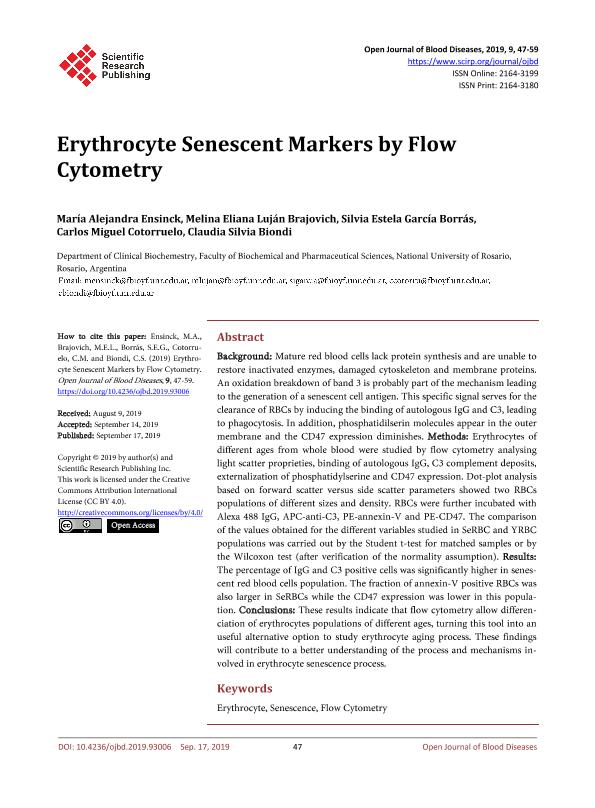Mostrar el registro sencillo del ítem
dc.contributor.author
Ensinck, María Alejandra

dc.contributor.author
Luján Brajovich, Melina Eliana

dc.contributor.author
García Borrás, Silvia Estela

dc.contributor.author
Cotorruelo, Carlos Miguel

dc.contributor.author
Biondi, Claudia Silvia

dc.date.available
2021-12-30T17:40:17Z
dc.date.issued
2019-06
dc.identifier.citation
Ensinck, María Alejandra; Luján Brajovich, Melina Eliana; García Borrás, Silvia Estela; Cotorruelo, Carlos Miguel; Biondi, Claudia Silvia; Erythrocyte Senescent Markers by Flow Cytometry; Scientific Research; Open Journal of Blood Diseases; 9; 3; 6-2019; 47-59
dc.identifier.issn
2164-3180
dc.identifier.uri
http://hdl.handle.net/11336/149466
dc.description.abstract
Background: Mature red blood cells lack protein synthesis and are unable to restore inactivated enzymes, damaged cytoskeleton and membrane proteins. An oxidation breakdown of band 3 is probably part of the mechanism leading to the generation of a senescent cell antigen. This specific signal serves for the clearance of RBCs by inducing the binding of autologous IgG and C3, leading to phagocytosis. In addition, phosphatidilserin molecules appear in the outer membrane and the CD47 expression diminishes. Methods: Erythrocytes of different ages from whole blood were studied by flow cytometry analysing light scatter proprieties, binding of autologous IgG, C3 complement deposits, externalization of phosphatidylserine and CD47 expression. Dot-plot analysis based on forward scatter versus side scatter parameters showed two RBCs populations of different sizes and density. RBCs were further incubated with Alexa 488 IgG, APC-anti-C3, PE-annexin-V and PE-CD47. The comparison of the values obtained for the different variables studied in SeRBC and YRBC populations was carried out by the Student t-test for matched samples or by the Wilcoxon test (after verification of the normality assumption). Results: The percentage of IgG and C3 positive cells was significantly higher in senescent red blood cells population. The fraction of annexin-V positive RBCs was also larger in SeRBCs while the CD47 expression was lower in this population. Conclusions: These results indicate that flow cytometry allow differenciation of erythrocytes populations of different ages, turning this tool into an useful alternative option to study erythrocyte aging process. These findings will contribute to a better understanding of the process and mechanisms involved in erythrocyte senescence process.
dc.format
application/pdf
dc.language.iso
eng
dc.publisher
Scientific Research
dc.rights
info:eu-repo/semantics/openAccess
dc.rights.uri
https://creativecommons.org/licenses/by/2.5/ar/
dc.subject
ERYTHROCYTE
dc.subject
SENESCENCE
dc.subject
FLOW CYTOMETRY
dc.subject.classification
Otras Ciencias de la Salud

dc.subject.classification
Ciencias de la Salud

dc.subject.classification
CIENCIAS MÉDICAS Y DE LA SALUD

dc.title
Erythrocyte Senescent Markers by Flow Cytometry
dc.type
info:eu-repo/semantics/article
dc.type
info:ar-repo/semantics/artículo
dc.type
info:eu-repo/semantics/publishedVersion
dc.date.updated
2020-11-30T15:24:31Z
dc.identifier.eissn
2164-3199
dc.journal.volume
9
dc.journal.number
3
dc.journal.pagination
47-59
dc.journal.pais
Estados Unidos

dc.description.fil
Fil: Ensinck, María Alejandra. Universidad Nacional de Rosario. Facultad de Ciencias Bioquímicas y Farmacéuticas; Argentina
dc.description.fil
Fil: Luján Brajovich, Melina Eliana. Consejo Nacional de Investigaciones Científicas y Técnicas. Centro Científico Tecnológico Conicet - Rosario. Instituto de Inmunología Clinica y Experimental de Rosario. Universidad Nacional de Rosario. Facultad de Ciencias Médicas. Instituto de Inmunología Clinica y Experimental de Rosario; Argentina
dc.description.fil
Fil: García Borrás, Silvia Estela. Universidad Nacional de Rosario. Facultad de Ciencias Bioquímicas y Farmacéuticas; Argentina
dc.description.fil
Fil: Cotorruelo, Carlos Miguel. Consejo Nacional de Investigaciones Científicas y Técnicas. Centro Científico Tecnológico Conicet - Rosario. Instituto de Inmunología Clinica y Experimental de Rosario. Universidad Nacional de Rosario. Facultad de Ciencias Médicas. Instituto de Inmunología Clinica y Experimental de Rosario; Argentina
dc.description.fil
Fil: Biondi, Claudia Silvia. Universidad Nacional de Rosario. Facultad de Ciencias Bioquímicas y Farmacéuticas; Argentina
dc.journal.title
Open Journal of Blood Diseases
dc.relation.alternativeid
info:eu-repo/semantics/altIdentifier/url/https://www.scirp.org/journal/paperinformation.aspx?paperid=95055
dc.relation.alternativeid
info:eu-repo/semantics/altIdentifier/doi/http://dx.doi.org/10.4236/ojbd.2019.93006
Archivos asociados
